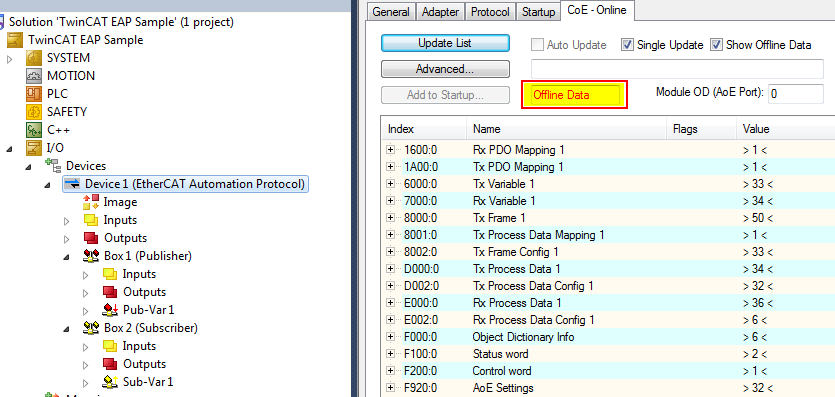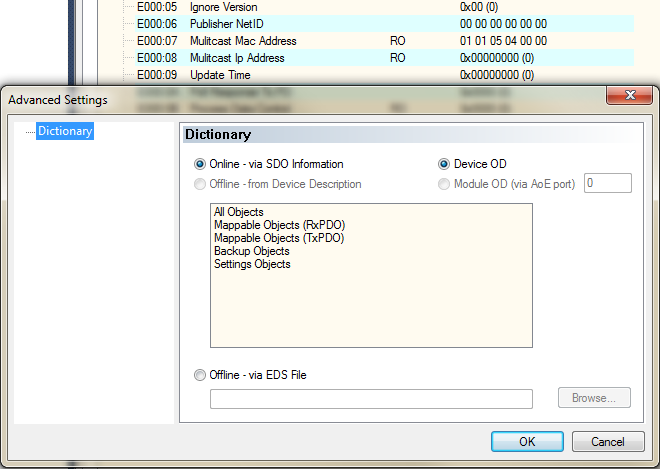The TwinCAT EAP device
The Network Interface Card (NIC) via which the EAP telegrams are to be sent and the AMS NetID with which the EAP device is to be reachable by ADS/AMS are specified with the help of the EAP device's configuration options. By selecting the Network Interface Card, the IP address (in the case of UDP/IP communication) via which the EAP device can be reached is then automatically specified. In addition, there is a possibility to access the object dictionary of the EAP device.
General
The standard dialog on the General tab exists for all TwinCAT devices and boxes. A descriptive name and a useful comment on the description of the device or box can be entered in this dialog.
Adapter
The dialog on the Adapter tab shows the selected Network Interface Card or enables an adapter to be assigned.
Protocol
The dialog on the Protocol tab (see next illustration) enables the assignment of a special AMS NetID via which the EAP device can be addressed by ADS/AMS during operation.
Furthermore there is an option by means of the [Export Configuration File…] button to export the current EAP configuration revision of the loaded project to an XML file. This XML file has a defined scheme and is also called the EAP Device Configuration (EDC).

CoE – Online
The dialog on the CoE - Online tab shows the EAP object dictionary (OD). Compare here the chapter The CANopen object dictionary and the following illustration.The object dictionary is automatically created as soon as a TwinCAT EAP device is configured with the help of TwinCAT. It includes all configuration information and is automatically extended or reduced by entries as soon as elements are added to or removed from the current configuration.

The control elements of the CoE - Online dialog have the following meanings:
Status
The status of the displayed object dictionary is output in a text field (with a yellow background in the illustration above). The status Offline Data is always displayed if TwinCAT has no connection to an activated EAP device. For example, a connection is not established if the configured AMS NetID differs from the actual AMS NetID of the activated EAP device. Otherwise the status Online Data is displayed:


In the online directory | In the offline directory |
|---|---|
the real current directory of the EAP device is read out. This may take several seconds, depending on the size and cycle time | the offline directory of the EAP device is displayed. In this case modifications are not meaningful or possible. |
a green Online can be seen in the TwinCAT dialog CoE - Online | a red Offline can be seen in the TwinCAT dialog CoE - Online |
 | Reading the online data of another EAP device instance There is an option to set the AMS NetID on the Protocol tab to the AMS NetID of any desired EAP device within the network in order to read out the online data by TwinCAT via the CoE – Online tab. To do this the EAP device must be activated and an ADS/AMS Route must exist to the device. |
Show Offline Data
With the aid of the Show Offline Data option you can set whether the contents of the object dictionary are to be displayed online or offline. Online means that the OD contents of the activated configuration are read from the EAP device and displayed. Offline means that the OD contents of the configuration that was configured with the help of TwinCAT in the currently loaded TwinCAT project are displayed.
Single Update
If the option Single Update is marked, the OD contents are always read from the EAP device precisely when an object is expanded (click on the "+" symbol) in order to display its sub-entries, or if you scroll within the window.
Auto Update
If the Auto Update option is marked, the OD contents for all visible sub-entries are read cyclically from the EAP device and the display is updated.
Update List
The purpose of the Update List button is to read the current OD contents of all visible object entries from the EAP device and to display them.
Advanced
The Advanced Settings dialog is opened by a click on the Advanced button (see following illustration). With the aid of this dialog the entire OD description or part of it can be read from the EAP device. This option is advantageous in particular when objects are added to or removed from the object dictionary during operation, because the displayed OD description in TwinCAT is then no longer consistent with the current OD of the EAP device.

Startup
From the object dictionary, TwinCAT generates a data stream consisting of a series of Startup commands that are transmitted to the EAP device. The transmission takes place as soon as the existing configuration is activated. The generated startup commands are displayed in the dialog on the Startup tab.